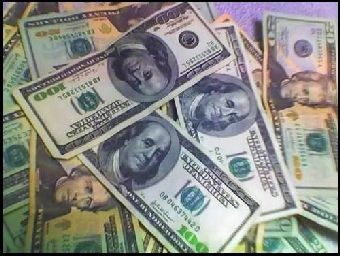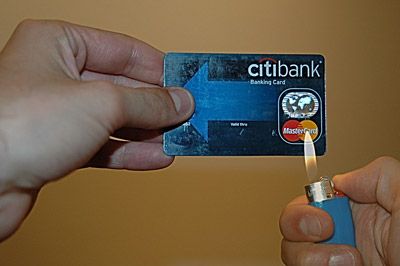
Publisher:
Bonnie King
CONTACT:
Newsroom@Salem-news.com
Advertising:
Adsales@Salem-news.com

~Truth~
~Justice~
~Peace~
TJP
Feb-14-2010 19:17

 TweetFollow @OregonNews
TweetFollow @OregonNews
Redline: A Critical Review of the Mortgage Crisis
Ersun Warnke Salem-News.com Business/Economy ReporterI drag the story of Daniel Sadek and his ill fated attempts at film making out of the dustbin of recent history in order to raise a question.
 Daniel Sadek's flop of a movie stressing "Fear Nothing Risk Everything" - may have a different legacy than planned. |
(EUGENE, Ore.) - If you haven’t heard of it, Redline is one the worst pieces of filmed entertainment ever made. It may however be recognized by posterity as the most acute documentary of the greed, stupidity, and excess of the first decade of the new millennium.
 Sadek talks to a FOX reporter |
Redline was produced and paid for by Daniel Sadek. The movie is a grandiose fantasy depiction of his own life. The plot is unimportant, but seems to revolve around a fleet of extremely expensive cars and high class whores. All of the cars in the $33 million dollar film were from Daniel Sadek’s personal collection.
Daniel Sadek was a car salesman in Orange County California until 2002, when he founded the company Quick Loan Funding. He proceeded to churn out $4 billion in mortgages, purchased and securitized by Citibank, Bank of America, Bear Stearns, Countrywide Home Loans, Lehman Brothers, Merrill Lynch, and Morgan Stanley.
If you don’t recognize the names of these companies, Citibank and Bank of America are now the two largest banks in the United States. These firms collectively have been given hundreds of billions of dollars by the U.S. taxpayers.
Go to your local video store and pay a few bucks to see what your tax dollars bought. I should warn you: this may have severe repercussions for your physical, mental, and emotional health. Don’t sue me if you reflexively gouge your eyes out.
I drag the story of Daniel Sadek and his ill fated attempts at film making out of the dustbin of recent history in order to raise a question.
Why would the largest financial institutions in the world pick a car salesman with no education or business experience to be their partner in issuing, securitizing, and selling $4 billion dollars in home mortgages? Did they have any second thoughts about their partnership when, in 2007, Sadek released his spectacle of a film with the tagline “Fear Nothing. Risk Everything.”?
 Investor Daniel Sadek during an on-camera role. Courtesy: hotflick.net |
The answers to these questions are simpler than one might expect. These financial institutions knew that lowering mortgage standards and partnering with petty hustlers would result in a flood of new mortgages, issued to people without the income to pay, and at values far in excess of the real value of the underlying properties. They knew that many of these borrowers would default. They knew that crisis would ensue.
These financial institutions also knew that this would be highly profitable for them.
To the casual observer of the evening news, it may not be readily apparent how a bank can profit from someone defaulting on their mortgage.
In order to explain the mechanics of this con, I will need to delve into the fundamental principals of banking, and explain some of the more arcane aspects of the economic mumbo-jumbo that these financial institutions created as the theatrical diversion for their frauds.
Banking, in the western world, is based on the interest hustle. Charging interest for lending money is fraudulent, pure and simple. (I can give you a stack of historical sources on this if you are concerned with my authority on this point)
In practice, charging interest first requires monopolizing the currency supply. In the old days, banks would have to corner the physical gold market in order to make this hustle work. Today, a government enforced monopoly on production of paper money is sufficient.

Monopolizing the currency supply is what unlocks the real potential of robbing people by charging them interest.
Suppose a bank takes a deposit of a pound of gold. They then lend the gold at interest, and require that two pounds be returned.
What does the borrower do with a pound of gold? If they borrowed it, they must spend it on something. The borrower spends the gold.
Now, the person who received the gold has a pound of gold. What do they do with it? It could be stolen by thieves at any time, so they deposit it in the bank to keep it safe.
Finally, the bank has the exact same amount of gold as before, except now someone owes them a pound of gold in interest.
This is a neat trick. With a bit of theatrics, an interest debt is created, even though the creditor lost nothing. How does a debt exist when the creditor has exactly what they started with? Ask a banker.
The banker response is always to point to the goods exchanged, the economic activity “created” by their lending, and so on. After all, the borrower did buy something with the gold. The person who sold something to the borrower did not have to re-deposit the gold with the bank. The bank could have lost its gold.
These are all good arguments for why the principal of a debt should be repaid, but they make no argument at all for why interest should be paid.
Charging interest is an old con. It has been around for thousands of years, and both the script and the theatrics involved have evolved considerably over time.

Modern financial institutions do not lend in gold. They lend in fiat currencies. In our particular case, we have the dollar. Modern financial institutions are viewed by government as a “necessary evil” although it is an open question as to who they are actually necessary for.
Since financial institutions create the money that they lend to people, this activity of money creation is regulated by the government.
The principal on which money creation works is that in a monopolized banking system, just like in the gold example, when a bank loans money, it ends up back in their accounts. Banks are thus allowed to lend out many times over the actual amount of cash they have.
For a very simple example, suppose a bank takes a savings deposit, and pays a half-a-percent in interest on it. The bank could then re-loan this amount up to nine times over, so they may get gross revenues of 30-40% per annum, while the savings account holder gets half-a-percent.
Reserve requirements only apply to deposits in accounts where cash can be withdrawn. They were created long ago to prevent classic bank runs, where everybody would try to get their cash at the same time, which of course means that the bank will not have it.
In order to create even more money, a bank must find a way to get around the reserve requirements for the money on deposit with them. At the beginning of the last decade, financial institutions discovered a new mechanism for doing this, called Collateralized Debt Obligations (CDO).
A CDO is a tradable bond that represents a share in a large collection of individual debts. CDOs are used to package and resell consumer credit card debts and mortgage debts, among other things.
How do CDOs allow banks to create new money?

Suppose Citibank loans $100,000 to Mike to buy a house. This $100,000 loan counts against Citibank’s reserve requirements, so it reduces their total lending capacity by $100,000. Now, Citibank puts that loan into a CDO. This CDO has only one mortgage in it, and it has a value of $100,000. Now, Citibank sells it to Jane, another Citibank customer, for $100,000. Jane moves $100,000 out of her Citibank checking account in order to buy the CDO.
Unlike other transactions, when Jane buys the CDO from Citibank, the money does not go anywhere else. Now that Citibank has $100,000 less in deposits, and $100,000 in fresh cash on its books, they are free to relend that money again. As before, assuming that this money can be lent out, re-deposited, and loaned again, this $100,000 could be turned into roughly $900,000 in new loans.
CDOs turn debts owed to banks into tradable securities, which allows them to be exchanged for funds deposited in people’s bank accounts. At the point of a person buying a CDO with deposited funds, the bank finds a loophole that allows them to dodge the limit on money creation imposed by reserve requirements.
Normally, whenever a person withdraws money from one bank account it is deposited in another bank account where the same reserve requirements apply. The total amount of money in the system does not change. The balance has only been shifted from one bank to another. However, when a bank sells debts owed to it as a CDO, money comes out of its deposits, and into the hands of the bank itself, allowing the bank to create even more money.
This example is very simple. In real life, this money creation cycle is being run through a maze of hundreds of different companies, including the ones mentioned above. The end effect is the same though: financial institutions creating money out of nothing and lending it to people at interest.
Money creation is obviously a profitable activity. If a financial institution can create money at no cost, then loan it to someone at interest, they have zero downside risk, and massive upside potential.

CDOs allow banks to create money in a new way. That means profit, but it also requires that banks issue a lot of mortgages. In order for the CDO money creation cycle to work, people have to be borrowing lots of money, and mortgages are by far the largest segment of consumer borrowing.
In order to get people borrowing, banks eliminated mortgage lending standards and created “sub-prime” mortgages. With CDOs, lending standards became irrelevant, because the banks could reap profits from money creation, even if the underlying mortgage had no chance of being repaid. All that was needed was to hire people like Daniel Sadek to get the ball rolling.
When financial institutions started making lots of new mortgage loans with no lending standards, the result was an increase in effective demand for real estate. This increase in effective demand drove up prices. It also resulted in churn, as people sold their existing homes, and bought new homes at inflated prices.
What is important to remember is that the bank can never lose. They created the money out of thin air. Even if 10% of mortgages default, this is only a loss on paper, and it reflects no actual investment losses. Meanwhile, by stimulating demand throughout the housing market, banks pushed up the cost of housing, and thus total mortgage borrowing, for everyone. If 90% of mortgages pay out at an inflated price, which means increased interest income for banks, the profits will be huge.
What is the extent of potential profit from mortgage and credit card related money creation?
According to Fed data, U.S. household debt increased from $6.4 trillion in 1999 to $13.8 trillion in 2007. Most of that debt is in home mortgages. Depending on how many people default, increased profits for financial institutions should be hundreds of billions of dollars or more.
The entire process of mortgage issuing for the past decade has been fundamentally fraudulent. This was not an accident. Like everyone else, the leading financial institutions in the country were well aware that people with no incomes could not pay off half-million dollar mortgages. They were well aware that their accomplices like Daniel Sadek were common criminals who would issue plenty of mortgages precisely to those who could not pay.
The leading financial institutions in this nation intentionally engaged in this activity because they knew that it would be profitable, and massively so. The victims of this fraud are not so much those who are being kicked out of their houses, but the 90% of the population who will keep their houses and pay off an inflated mortgage over the next 30 years.
 Salem-News.com Business/Economy Reporter Ersun Warncke is a native Oregonian. He has a degree in Economics from Portland State University and studied Law at University of Oregon. At a young age, his career spans a wide variety of fields, from fast food, to union labor, to computer programming. He has published works concerning economics, business, government, and media on blogs for several years. He currently works as an independent software designer specializing in web based applications, open source software, and peer-to-peer (P2P) applications.
Salem-News.com Business/Economy Reporter Ersun Warncke is a native Oregonian. He has a degree in Economics from Portland State University and studied Law at University of Oregon. At a young age, his career spans a wide variety of fields, from fast food, to union labor, to computer programming. He has published works concerning economics, business, government, and media on blogs for several years. He currently works as an independent software designer specializing in web based applications, open source software, and peer-to-peer (P2P) applications.
Ersun describes his writing as being "in the language of the boardroom from the perspective of the shop floor." He adds that "he has no education in journalism other than reading Hunter S. Thompson." But along with life comes the real experience that indeed creates quality writers. Right now, every detail that can help the general public get ahead in life financially, is of paramount importance.
You can write to Ersun at: warncke@comcast.net
Articles for February 13, 2010 | Articles for February 14, 2010 | Articles for February 15, 2010





Terms of Service | Privacy Policy
All comments and messages are approved by people and self promotional links or unacceptable comments are denied.
jmb27 February 28, 2010 11:27 am (Pacific time)
Predatory Lending is a major contributor to the economic turmoil we are currently experiencing. Here is an example of what I am talking about: Scott Veerkamp / Predatory Lending (Franklin Township School Board Member.) Please review this information from U.S. Senator Jeff Merkley regarding deceptive lending practices: "Steering payments were made to brokers who enticed unsuspecting homeowners into deceptive and expensive mortgages. These secret bonus payments, often called Yield Spread Premiums, turned home mortgages into a SCAM." The Center for Responsible Lending says YSP "steals equity from struggling families." 1. Scott collected nearly $10,000 on two separate mortgages using YSP and junk fees. 2. This is an average of $5,000 per loan. 3. The median value of the properties was $135,000. 4. Clearly, this type of lending represents a major ripoff for consumers. http://merkley.senate.gov/newsroom/press/release/?id=A09C6A80-537A-4EB1-83C5-31925F046B6F
jmb27 February 25, 2010 2:26 pm (Pacific time)
Predatory Lending is a major contributor to the economic turmoil we are currently experiencing. Here is an example of what I am talking about: Scott Veerkamp / Predatory Lending (Franklin Township School Board Member.) Please review this information from U.S. Senator Jeff Merkley regarding deceptive lending practices: "Steering payments were made to brokers who enticed unsuspecting homeowners into deceptive and expensive mortgages. These secret bonus payments, often called Yield Spread Premiums, turned home mortgages into a SCAM." The Center for Responsible Lending says YSP "steals equity from struggling families." 1. Scott collected nearly $10,000 on two separate mortgages using YSP and junk fees. 2. This is an average of $5,000 per loan. 3. The median value of the properties was $135,000. 4. Clearly, this type of lending represents a major ripoff for consumers. http://merkley.senate.gov/newsroom/press/release/?id=A09C6A80-537A-4EB1-83C5-31925F046B6F
Ersun Warncke February 15, 2010 11:08 am (Pacific time)
Greg, the thing to recognize is that there is no risk in the traditional sense, because nothing was invested. The bank just creates the money, so they are not risking anything. However, if they become insolvent on paper, they still have to go bankrupt. The Banks wrote a ton of bad loans. They do not lose anything when the loans aren't paid, but they have to stay out of bankruptcy/nationalization if they are going to survive to collect the cream (the 90% of people paying out inflated mortgages). Also, a business this lucrative is highly competitive. There is genuinely a large amount of competition in the financial sector. It is just people competing over the rights to rip off the bulk of the population, as opposed to something slightly more socially productive. Many financial institutions come and go, and see their fortunes rise and fall, due to the intense competition in this sector.
me February 15, 2010 10:06 am (Pacific time)
Good argument for strategic loan default... so how do we paint targets on those responsible?
greg February 15, 2010 9:47 am (Pacific time)
if as the author states "...zero downside risk..." how come so many banks and financial firms failed and so many more needed to be bailed out?
gp February 15, 2010 4:50 am (Pacific time)
This is the clearest description of the creation of money that I have read. Thanks Ersun.
[Return to Top]©2025 Salem-News.com. All opinions expressed in this article are those of the author and do not necessarily reflect those of Salem-News.com.